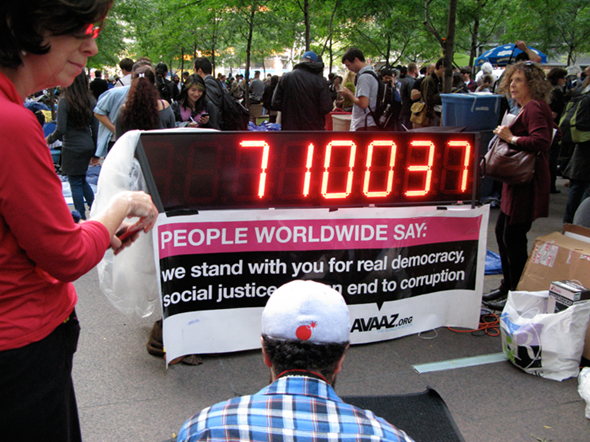
Occupy Wall Street was initially met by mainstream media and politicians with sarcasm; begrudgingly tolerated as a half-assed, badly organized tantrum which would soon evaporate. However, it looks as if proponents of OWS have consistently increased in numbers. Adam E. Mendelsohn speaks plainly about this »people-powered movement« and asks friends and colleagues from various pockets of the art world for their comments.
Only a week before September 17th 2011, the date when Occupy Wall Street officially occupied Zuccotti Park in Lower Manhattan, I was writing a friend asking: »Why aren’t people taking to the streets!!!?« What many people don’t yet understand, is that OWS (along with the October 2011 movement) is a legitimate protest, quite well thought-out, and quite well organized, it can in my opinion only gain momentum. Set amidst the Republican primary election campaigns, frontrunners Mitt Romney and Herman Cain have, in the space of just two weeks, already tailored their statements regarding the protest from, »Get a job!« to »We understand their frustration,« proving that they acknowledge that this isn’t going away. Six weeks into the protest it’s clear that OWS is a serious and valid non-violent protest that innovates the great tradition of the American non-violent protest. Not just because Noam Chomsky, Susan Sarandon, Slavoj Žižek, Bill Clinton, Joan Baez, Russell Simmons, Bill Maher, Pete Seeger, Crosby & Nash (who played a concert), and Stephen Colbert have made their support for it known publicly, but because it has real momentum. Youthful momentum you might even say. People (not just 20 somethings) from all over the country have even quit their jobs to join the protestors in NYC. So far, OWS has generated remarkably little violence (they have their own internal security system) and apart from a few fairly minor incidences there has been very little damage to public property. Despite appearances, it is a competent, sophisticated organization. Anyone with any degree of objectivity or historical perspective can easily see that at the moment it is successfully peaceful.
A major complaint from people going about their daily business in and around Zuccotti Park is the putrid smell, and it’s true, there are very few public toilets nearby or in Lower Manhattan in general. This is one of the many decisive facts about the occupation – a basic affront to daily life
(NYC smells bad enough
as it is) and an assault on
the senses that has absolute
primacy. People who feel
strongly that the protestors
embody »smelly hippies«
are all the more likely to either blunder, by acting aggressively out of frustration, or cave sooner, if only to get rid of the, »disgusting looking, smelly losers« as one prominent individual put it. And since there’s no official leader and no specific demands so far, OWS is tactically brilliant from a strategic point of view. When there is enough public support, and enough »inconvenience« (I believe there will be, given that America is a country that functions on convenience) OWS will have, in theory at least, built up a reservoir of leverage with which to effectively negotiate. Also key is that it has yet to be co-opted by either corporate interest or by a political party, including the Democrats (although rapper/mogul Jay-Z’s Rocawear label is somewhat distastefully selling t-shirts with the slogan »Occupy All Streets«). The perception that OWS is a largely Democratic movement is inaccurate, and it doesn’t really belong to any tradition of socialist or communist public protest.
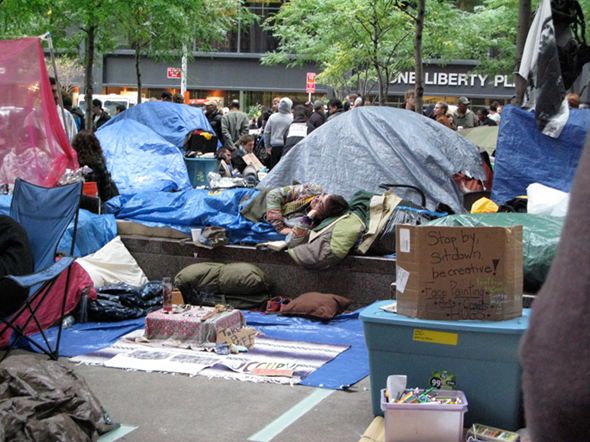
Why are people doing this? The easy answer is that the nation as a whole feels overwhelmingly cheated and robbed at a very basic level – it is an almost biological response. No one really wants to end Wall Street trading or overthrow the government; they want both to function properly and with higher standards of ethical oversight. I believe that people are desperate for accountability and for the criminals that are involved in knowingly sabotaging specific financial markets to be justly prosecuted.
People are desperate
for Obama to make
good on his pre-election promises, and are asking for government to function effectively without corrupt corporate control of a lobbyist, house-of-mirrors Washington. We all know that the economic situation is very complex (economics have replaced philosophy), but the reality is that very few people can effectively explain what is wrong, what went wrong and what is about to go wrong, and the majority of people do not have time to spend six months studying the dazzlingly complex reasons why. Meanwhile, Congress currently seems to be deliberately debating the astonishingly retardataire issue of whether »In God We Trust« should be re-affirmed as the slogan on American currency. Rather than do nothing, people are responding. It’s healthy.
At this stage, it’s critical for observers from afar to decode the images and news reports of protestors that are disseminated through mainstream media outlets. Very few media networks are providing balanced audiovisual accounts of what is actually happening, and many right wing media giants such as Fox News are still try ing to sell their viewers the idea that it is the »hippies vs. the hard-hats,« as was the case during the Vietnam war protests of the 60s (and a contributing factor to ending that war). Currently, there are many pictures showing »hard-hats« side-by-side with »hippies« or »hipsters.« This type of divide-and-conquer media coverage will almost certainly fail this time.
The Art World has been sluggish, sheepish, and limp in response. My impression is that it is embarrassed – an interesting although confusing self-deception. Commercially, the art world has barely even noticed. Recent auction sales weren’t total disasters (although the Sotheby’s and Christie’s post-war sales were noticeably poor as OWS protestors paraded outside their Manhattan headquarters with a marching band), apparently fairs are going swimmingly, Performa 11 is thriving, and numberless galleries are enjoying busy fall openings. Many artists that I asked to comment flatly refused because they were either »too busy« or felt that they might alienate potential clients. This is dire in my view ... a sort of Post-Modern McCarthyism that you might expect from 80% of dealers, but artists? And since most major American institutions (museums, universities) receive private funding, many seem to feel that silence is the best response. A major case could be made on behalf of important museums that have been abandoned in favor of banking institutions in terms of government distribution of much needed resources to care for our national treasures. What do I think can help this country? Innovate or die.
OCCUPYWALLST.ORG
OCTOBER2011.ORG
ADAM E. MENDELSOHN is an artist and a critic, currently residing at no fixed address.
Images by CHRISTINE WÜRMELL.
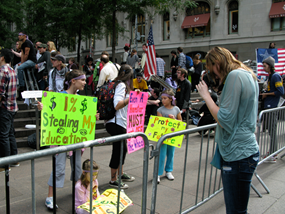
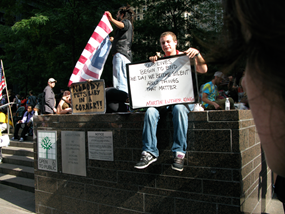


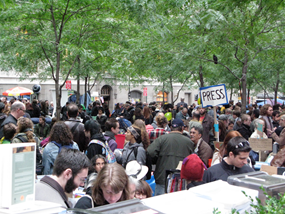



MARTHA ROSLER (artist, activist)
The US »Tea Party« movement, under false flag, delighted the media; their agitations were scrupulously reported. The following year Maghreb erupted and the character of protest assumed new configurations. Tahrir Square writes to Occupy Wall Street: »An entire generation across the globe has grown up realizing, rationally and emotionally, that we have no future in the current order of things ...we stand with you not just in your attempts to bring down the old but to experiment with the new.« We are not protesting ... We are occupying. We are reclaiming those same spaces of public practice that have been commodified, privatized and locked into the hands of faceless bureaucracy, real estate portfolios and police »protection.« Hold on to these spaces, nurture them and let the boundaries of your occupations grow.
An occupation’s first goal is spatiotemporal visibility. Programs and platforms will be hammered out over time, and with far more autonomy than the Tea Party — but not in opposition to its protests against bipartisan betrayal. Speaking as an artist, whose assigned role in urban planning is to gentrify space for the rich, I see the occupation movement as the arrival of the conflict between the »creatives« and the city that uses them.
DAVID COHEN (critic)
At the risk of incurring wrath from both artists and protesters, allow me to assume that OWS is a show – which it is, after all – and offer a review.
The first thing to say is how spectacularly un-visual the protests are. Of course, there is an Arte Povera aesthetics, of sorts, in the makeshift grunge of the campsite. The attire of occupiers is predictable, but then, how does one dress for a revolution? It seems the paradigm is Paris, 1968. Apart from their holding cell phones, and if one looks closely at the younger and more anarchist-affiliated participants, sporting tattoos, there is very little to distinguish the average protester in 2011 in New York from the average Parisian in 1968. Except that the latter were generally more stylish – leather jackets etc. – although, in fairness, the »events« were in summer not fall. Consider, by contrast, how very different ’68ers were from leftist protesters a decade earlier. Communists in France took pride in their leaders wearing their Sunday best, a distinguishing feature from Trotskyists (despite the fact that Leon was a natty dresser) and from the New Left.
Visiting Zuccotti Square is hard work on the eye. Protesters often carry placards with text that is dense both in the literary and visual senses: from the graphic design perspective, most placards are a disaster: small letters, hand written, that get bounced around like babies, as if to literalize the notion of activist. Texts deploy narrative and irony, which militate against conceptual gestalt. There were, to be sure, skillful, thoughtful, witty slogans held still and written in block capitals: »KEEP YOUR COINS I WANT CHANGE« was a striking one. And one guy I saw had really made an effort by wearing a pinstripe jacket adorned by corporate logos, posing as Senator Ebenezer de Monet, a punning name that, alas, took explaining. But a preponderance of well designed placards would themselves be signs of something wholly out of place at OWS, corporate leadership and purpose. Playing by the same rules as advertising would represent a defeat of countercultural values. Besides the golden calf carried through the crowd one day by clergymen, the protests have not produced a Lady Liberty icon along the lines of Tiananmen Square. Might this perhaps reflect the fact that Zuccotti has one already, courtesy of sponsorship, in the form of Mark di Suvero’s Joie de Vivre, one of his trademark, exuberant, bright red pylons? There seems something ironic and forlorn about the sculpture’s newfound context. Here is a work of art that is derived directly from Russian constructivism, adorning a public park in the midst of the global financial system, and seemingly received with indifference by heirs of the revolution that supplied the sculpture’s cultural signifiers.
SUSAN AND MICHAEL HORT (collectors)
We support the protesters. Something must be done with the disparity in incomes and taxes. The financial sector is still fighting against regulation so that they can make outsized profits by borrowing money from the federal government at less than 1%; they then lend it to the governments of Italy and Greece instead of to deserving companies and individuals, knowing that if they run into trouble they will bailed out.
MICHAEL WETZEL (artist)
It's about time really, the class war has been on since the 80s, since Reagan. Why else abolish Social Security unless you want to eliminate the middle class? The 1% has had a good long hassle free run. Fortunately there are enough reasonably minded individuals up there who are interested in a sustainable democracy. There are enough people on both sides that know that when there is not enough bread to go around the circus people get upset, hungry and upset. Historically people have gotten very upset. And then no one makes any money. OWS seems to be staying well on the right side of history which will hopefully make positive changes in the government and alter the tax system, energy policy, immigration etc. Who knows, maybe we can move past the Calvinist’s two class colonial mentality (Loyalist really since it is anti-democracy) and prosper. It would be nice to see them take the money and go directly to jail for once.
FELIX GMELIN (artist)
Looking back doesn’t necessarily mean nostalgia. It can also mean finding past potential futures shed out by »progress«. There is a beautiful theory that German art historian Inke Arns calls Retro-Utopianism. With this she talks about artists, mainly from Eastern Europe, who give their attention to what has been left in a state of potentiality, through this interest they can be considered to be part of a »politics of hope« for the future.
By a coincidence, I happened to be at Plaza del Sol, Madrid in May of this year and have come to think of the M15 movement as transforming Inke’s ideas into practice. I was impressed by the awareness they had regarding history and by how they aimed to avoid repeating potentially totalitarian mistakes of former avant-garde movements. I also understood that in opposition to the claim of Francis Fukuyama’s 1989 essay The End of History, hopes for alternative society models to capitalism are far from over.
We should re-write his text to match the current political developments. Maybe now that Turbo-Capitalism seems to be in free fall there is necessary political incitement for a real change. An incitement that obviously wasn’t there when the 1968 student movement hit the political realities of the Cold War status quo almost half a century ago.
When Spanish writer and economist José Luis Sampedro Sáez says that this system is disintegrated and corrupted, and is really breaking down – that change will be impossible to avoid – I believe him.
